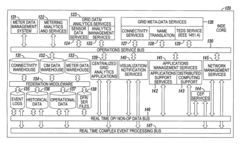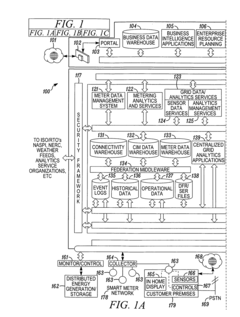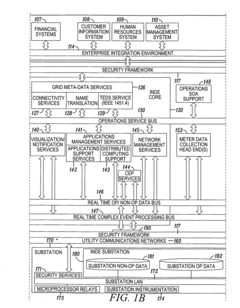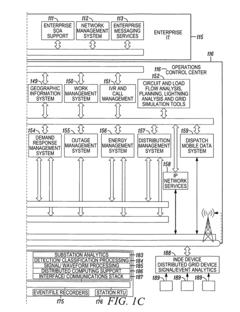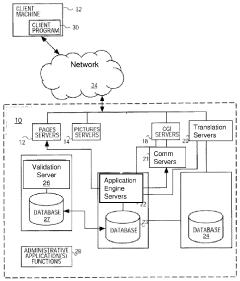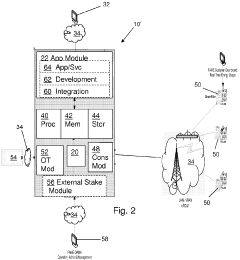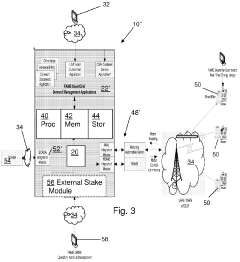Throttle Body Applications in Smart Grid Management
JUL 18, 20259 MIN READ
Generate Your Research Report Instantly with AI Agent
Patsnap Eureka helps you evaluate technical feasibility & market potential.
Smart Grid Evolution
The evolution of smart grids represents a significant transformation in the way electricity is generated, distributed, and consumed. This technological advancement has been driven by the need for more efficient, reliable, and sustainable power systems. The journey of smart grid development can be traced back to the early 2000s when the concept first gained traction among utility companies and policymakers.
Initially, smart grids focused on integrating digital technologies into the existing power infrastructure. This phase saw the introduction of smart meters, which allowed for two-way communication between consumers and utility providers. These devices enabled real-time monitoring of energy consumption and paved the way for more dynamic pricing models.
As the technology progressed, the emphasis shifted towards incorporating renewable energy sources into the grid. This phase presented new challenges, particularly in managing the intermittent nature of solar and wind power. To address these issues, advanced forecasting tools and energy storage solutions were developed, enhancing the grid's ability to balance supply and demand.
The next stage in smart grid evolution involved the implementation of demand response programs. These initiatives empowered consumers to actively participate in energy management by adjusting their consumption patterns based on grid conditions. This bidirectional flow of information and energy marked a significant departure from traditional, unidirectional power systems.
Recent years have witnessed the emergence of microgrids and distributed energy resources (DERs) as key components of smart grid architecture. These localized power systems can operate independently or in conjunction with the main grid, offering increased resilience and flexibility. The integration of DERs has necessitated the development of advanced control systems and grid management algorithms.
The current phase of smart grid evolution is characterized by the incorporation of artificial intelligence and machine learning technologies. These tools are being leveraged to optimize grid operations, predict equipment failures, and enhance cybersecurity measures. The use of big data analytics is enabling more accurate load forecasting and improved asset management strategies.
Looking ahead, the future of smart grids is likely to be shaped by the increasing electrification of transportation and heating sectors. This trend will require further advancements in grid capacity and management techniques. Additionally, the concept of transactive energy systems, where consumers can buy and sell energy in real-time markets, is gaining traction and may represent the next frontier in smart grid evolution.
Throughout this evolutionary process, the role of throttle body applications in smart grid management has become increasingly important. These devices, traditionally used in automotive applications, are finding new purpose in controlling energy flow within smart grids. Their ability to precisely regulate the flow of resources, whether it be electricity or data, makes them valuable components in the complex ecosystem of modern power systems.
Initially, smart grids focused on integrating digital technologies into the existing power infrastructure. This phase saw the introduction of smart meters, which allowed for two-way communication between consumers and utility providers. These devices enabled real-time monitoring of energy consumption and paved the way for more dynamic pricing models.
As the technology progressed, the emphasis shifted towards incorporating renewable energy sources into the grid. This phase presented new challenges, particularly in managing the intermittent nature of solar and wind power. To address these issues, advanced forecasting tools and energy storage solutions were developed, enhancing the grid's ability to balance supply and demand.
The next stage in smart grid evolution involved the implementation of demand response programs. These initiatives empowered consumers to actively participate in energy management by adjusting their consumption patterns based on grid conditions. This bidirectional flow of information and energy marked a significant departure from traditional, unidirectional power systems.
Recent years have witnessed the emergence of microgrids and distributed energy resources (DERs) as key components of smart grid architecture. These localized power systems can operate independently or in conjunction with the main grid, offering increased resilience and flexibility. The integration of DERs has necessitated the development of advanced control systems and grid management algorithms.
The current phase of smart grid evolution is characterized by the incorporation of artificial intelligence and machine learning technologies. These tools are being leveraged to optimize grid operations, predict equipment failures, and enhance cybersecurity measures. The use of big data analytics is enabling more accurate load forecasting and improved asset management strategies.
Looking ahead, the future of smart grids is likely to be shaped by the increasing electrification of transportation and heating sectors. This trend will require further advancements in grid capacity and management techniques. Additionally, the concept of transactive energy systems, where consumers can buy and sell energy in real-time markets, is gaining traction and may represent the next frontier in smart grid evolution.
Throughout this evolutionary process, the role of throttle body applications in smart grid management has become increasingly important. These devices, traditionally used in automotive applications, are finding new purpose in controlling energy flow within smart grids. Their ability to precisely regulate the flow of resources, whether it be electricity or data, makes them valuable components in the complex ecosystem of modern power systems.
Throttle Body Market
The throttle body market has experienced significant growth in recent years, driven by the increasing demand for fuel-efficient vehicles and the integration of advanced technologies in automotive systems. This market segment is closely tied to the automotive industry's overall performance and is influenced by factors such as vehicle production rates, emission regulations, and consumer preferences for improved fuel economy.
In the context of smart grid management, throttle bodies are finding new applications beyond their traditional use in internal combustion engines. The market for throttle bodies in smart grid systems is emerging as a niche but promising sector, with potential for substantial growth as energy management becomes increasingly sophisticated.
The global throttle body market size was valued at approximately $2.5 billion in 2020 and is projected to reach $3.8 billion by 2026, growing at a CAGR of around 5.2% during the forecast period. This growth is attributed to the rising adoption of electronic throttle control systems in vehicles and the increasing focus on reducing vehicle emissions.
Geographically, Asia Pacific dominates the throttle body market, accounting for over 40% of the global market share. This is primarily due to the high vehicle production rates in countries like China, Japan, and South Korea. North America and Europe follow closely, driven by stringent emission norms and the presence of major automotive manufacturers.
In the smart grid sector, the market for throttle body applications is still in its nascent stages but shows promising growth potential. As smart grids evolve to incorporate more renewable energy sources and demand-response systems, throttle bodies are being adapted to control energy flow and optimize grid performance. This application is expected to create new opportunities for throttle body manufacturers and contribute to market expansion.
Key players in the throttle body market include Bosch, Continental AG, Delphi Technologies, Denso Corporation, and Hitachi Automotive Systems. These companies are investing heavily in research and development to improve throttle body efficiency and adapt their products for smart grid applications. The market is characterized by intense competition and a focus on technological innovation to gain a competitive edge.
The integration of IoT and AI technologies in throttle body systems is a growing trend, enabling more precise control and real-time monitoring of energy flow in both automotive and smart grid applications. This technological advancement is expected to drive market growth and open up new avenues for product development and market expansion in the coming years.
In the context of smart grid management, throttle bodies are finding new applications beyond their traditional use in internal combustion engines. The market for throttle bodies in smart grid systems is emerging as a niche but promising sector, with potential for substantial growth as energy management becomes increasingly sophisticated.
The global throttle body market size was valued at approximately $2.5 billion in 2020 and is projected to reach $3.8 billion by 2026, growing at a CAGR of around 5.2% during the forecast period. This growth is attributed to the rising adoption of electronic throttle control systems in vehicles and the increasing focus on reducing vehicle emissions.
Geographically, Asia Pacific dominates the throttle body market, accounting for over 40% of the global market share. This is primarily due to the high vehicle production rates in countries like China, Japan, and South Korea. North America and Europe follow closely, driven by stringent emission norms and the presence of major automotive manufacturers.
In the smart grid sector, the market for throttle body applications is still in its nascent stages but shows promising growth potential. As smart grids evolve to incorporate more renewable energy sources and demand-response systems, throttle bodies are being adapted to control energy flow and optimize grid performance. This application is expected to create new opportunities for throttle body manufacturers and contribute to market expansion.
Key players in the throttle body market include Bosch, Continental AG, Delphi Technologies, Denso Corporation, and Hitachi Automotive Systems. These companies are investing heavily in research and development to improve throttle body efficiency and adapt their products for smart grid applications. The market is characterized by intense competition and a focus on technological innovation to gain a competitive edge.
The integration of IoT and AI technologies in throttle body systems is a growing trend, enabling more precise control and real-time monitoring of energy flow in both automotive and smart grid applications. This technological advancement is expected to drive market growth and open up new avenues for product development and market expansion in the coming years.
Technical Challenges
The integration of throttle body applications in smart grid management presents several significant technical challenges that need to be addressed for successful implementation. One of the primary obstacles is the complexity of coordinating multiple throttle bodies across a vast and interconnected power grid system. This requires sophisticated control algorithms and communication protocols to ensure seamless operation and prevent potential conflicts or instabilities.
Another major challenge lies in the real-time data processing and decision-making capabilities required for effective throttle body control. The smart grid generates enormous amounts of data from various sensors and devices, which must be analyzed and acted upon instantaneously to maintain grid stability and optimize energy distribution. This necessitates advanced data analytics and machine learning techniques to handle the volume, velocity, and variety of information effectively.
The reliability and security of throttle body systems in smart grids also pose significant technical hurdles. As critical components of the power infrastructure, these systems must be designed to withstand potential cyber-attacks, physical tampering, and environmental factors. Ensuring robust security measures and fail-safe mechanisms is crucial to prevent unauthorized access or manipulation that could lead to grid disruptions or blackouts.
Interoperability between different throttle body systems and existing grid infrastructure presents another challenge. The smart grid ecosystem comprises a diverse range of technologies and standards from various manufacturers and utility providers. Developing standardized interfaces and protocols to enable seamless integration and communication between these disparate systems is essential for achieving optimal performance and scalability.
Energy efficiency and power quality management are additional technical concerns in throttle body applications for smart grids. The dynamic nature of renewable energy sources and fluctuating demand patterns requires precise control of power flow to maintain voltage stability and minimize losses. Designing throttle body systems that can rapidly adjust to these changing conditions while maximizing energy efficiency is a complex engineering task.
Furthermore, the development of accurate modeling and simulation tools for throttle body behavior in smart grid environments is challenging. These tools are crucial for predicting system performance, optimizing control strategies, and identifying potential issues before deployment. However, creating models that accurately represent the complex interactions between throttle bodies and other grid components requires extensive research and validation.
Lastly, the scalability and adaptability of throttle body applications in smart grids present ongoing technical challenges. As power grids continue to evolve and expand, throttle body systems must be designed to accommodate future growth and technological advancements. This requires flexible architectures and modular designs that can be easily upgraded or reconfigured to meet changing grid requirements and incorporate new functionalities.
Another major challenge lies in the real-time data processing and decision-making capabilities required for effective throttle body control. The smart grid generates enormous amounts of data from various sensors and devices, which must be analyzed and acted upon instantaneously to maintain grid stability and optimize energy distribution. This necessitates advanced data analytics and machine learning techniques to handle the volume, velocity, and variety of information effectively.
The reliability and security of throttle body systems in smart grids also pose significant technical hurdles. As critical components of the power infrastructure, these systems must be designed to withstand potential cyber-attacks, physical tampering, and environmental factors. Ensuring robust security measures and fail-safe mechanisms is crucial to prevent unauthorized access or manipulation that could lead to grid disruptions or blackouts.
Interoperability between different throttle body systems and existing grid infrastructure presents another challenge. The smart grid ecosystem comprises a diverse range of technologies and standards from various manufacturers and utility providers. Developing standardized interfaces and protocols to enable seamless integration and communication between these disparate systems is essential for achieving optimal performance and scalability.
Energy efficiency and power quality management are additional technical concerns in throttle body applications for smart grids. The dynamic nature of renewable energy sources and fluctuating demand patterns requires precise control of power flow to maintain voltage stability and minimize losses. Designing throttle body systems that can rapidly adjust to these changing conditions while maximizing energy efficiency is a complex engineering task.
Furthermore, the development of accurate modeling and simulation tools for throttle body behavior in smart grid environments is challenging. These tools are crucial for predicting system performance, optimizing control strategies, and identifying potential issues before deployment. However, creating models that accurately represent the complex interactions between throttle bodies and other grid components requires extensive research and validation.
Lastly, the scalability and adaptability of throttle body applications in smart grids present ongoing technical challenges. As power grids continue to evolve and expand, throttle body systems must be designed to accommodate future growth and technological advancements. This requires flexible architectures and modular designs that can be easily upgraded or reconfigured to meet changing grid requirements and incorporate new functionalities.
Current Solutions
01 Throttle body design and construction
Throttle bodies are designed to control airflow into an engine's intake manifold. They typically consist of a housing with a butterfly valve that can be opened or closed to regulate air intake. Various designs focus on improving airflow efficiency, reducing turbulence, and enhancing overall engine performance.- Throttle body design and construction: Throttle bodies are designed to control airflow into an engine's intake manifold. They typically consist of a housing with a butterfly valve that can be opened or closed to regulate air intake. Various designs focus on improving airflow efficiency, reducing turbulence, and enhancing engine performance.
- Electronic throttle control systems: Modern throttle bodies often incorporate electronic control systems, replacing mechanical linkages with sensors and actuators. These systems allow for more precise control of engine performance, improved fuel efficiency, and integration with other vehicle systems such as traction control and cruise control.
- Throttle body cleaning and maintenance: Throttle bodies can accumulate carbon deposits and other contaminants over time, affecting their performance. Various cleaning methods and maintenance procedures have been developed to ensure optimal throttle body function, including specialized cleaning solutions and tools for removing buildup without damaging sensitive components.
- Throttle position sensors and feedback mechanisms: Accurate sensing of throttle position is crucial for engine management systems. Throttle bodies often incorporate position sensors that provide feedback to the engine control unit. These sensors help ensure precise control of air-fuel mixture and engine timing, contributing to improved performance and emissions control.
- Integration with fuel injection systems: Modern throttle bodies are often designed to work in conjunction with fuel injection systems. This integration allows for more precise control of the air-fuel mixture, resulting in improved engine efficiency, power output, and emissions control. Some designs incorporate fuel injectors directly into the throttle body assembly.
02 Electronic throttle control systems
Modern throttle bodies often incorporate electronic control systems, replacing mechanical linkages with sensors and actuators. These systems allow for more precise control of the throttle position, improving fuel efficiency and engine response. They can also integrate with other engine management systems for optimized performance.Expand Specific Solutions03 Idle air control mechanisms
Throttle bodies may include idle air control mechanisms to regulate engine speed during idle conditions. These systems can bypass the main throttle plate to provide a controlled amount of air, maintaining stable idle speeds and smooth engine operation. Various designs aim to improve idle stability and reduce emissions.Expand Specific Solutions04 Throttle body cleaning and maintenance
Throttle bodies can accumulate carbon deposits and other contaminants over time, affecting their performance. Designs that facilitate easy cleaning and maintenance are important. Some throttle bodies incorporate self-cleaning mechanisms or materials that resist deposit buildup to maintain optimal airflow and throttle response.Expand Specific Solutions05 Integration with fuel injection systems
Modern throttle bodies are often designed to work in conjunction with fuel injection systems. This integration allows for precise control of the air-fuel mixture, improving engine efficiency and reducing emissions. Some designs incorporate fuel injectors directly into the throttle body assembly for better atomization and mixing of fuel with incoming air.Expand Specific Solutions
Key Industry Players
The throttle body applications in smart grid management represent an emerging field at the intersection of automotive technology and energy management. This sector is in its early growth stage, with a rapidly expanding market driven by the increasing adoption of smart grid systems globally. The technology is still evolving, with varying levels of maturity across different applications. Key players like Microsoft Technology Licensing LLC, IBM, and Ericsson are leveraging their expertise in software and telecommunications to develop advanced solutions. Automotive companies such as GM Global Technology Operations LLC and BYD Co., Ltd. are also entering this space, integrating their vehicle-specific knowledge with smart grid technologies. The convergence of these diverse industry leaders indicates a highly competitive and innovative landscape poised for significant growth.
International Business Machines Corp.
Technical Solution: IBM has developed a sophisticated throttle body application for smart grid management leveraging their expertise in AI and cloud computing. Their solution, part of the IBM Intelligent Utility Network, uses advanced sensors and actuators in throttle bodies to dynamically control power flow across the grid. The system employs IBM's Watson AI to analyze vast amounts of real-time data from grid sensors, weather forecasts, and energy market conditions to optimize throttle body positions[2]. This enables precise load balancing, demand response, and integration of renewable energy sources. IBM's throttle body application also incorporates blockchain technology for secure, decentralized control and transactions in distributed energy systems[4]. The solution can scale from individual microgrids to city-wide smart grid implementations, offering flexible deployment options.
Strengths: Powerful AI-driven optimization, scalable architecture, and integration of cutting-edge technologies like blockchain. Weaknesses: High initial implementation costs and potential complexity for smaller utility companies.
GM Global Technology Operations LLC
Technical Solution: GM has adapted its automotive throttle body technology for use in smart grid management applications. Their solution leverages GM's expertise in precision control systems to develop highly responsive throttle bodies for controlling power flow in electrical grids. The system utilizes advanced materials and manufacturing techniques to create throttle bodies capable of withstanding the high voltages and currents present in power distribution systems[9]. GM's throttle body application incorporates adaptive control algorithms that can quickly respond to changes in grid frequency and voltage, helping to maintain stability during sudden load changes or renewable energy fluctuations. The technology also features integrated diagnostics and prognostics capabilities, allowing for predictive maintenance and reducing downtime in critical grid infrastructure[10].
Strengths: Robust and reliable hardware design, fast response times, and advanced diagnostics capabilities. Weaknesses: Limited experience in utility-scale deployments and potential need for partnerships with established grid technology providers.
Core Innovations
Method and system for managing a power grid
PatentInactiveUS20090281673A1
Innovation
- The implementation of a smart grid system utilizing sensors, robust communications, and distributed computing to collect and analyze data across the power grid, enabling real-time analytics, fault detection, and automatic correction, with a centralized management facility and distributed intelligence at various grid components.
Enterprise smart grid and demand management platform and methods for application development and management
PatentInactiveAU2010270601B2
Innovation
- A computer-implemented platform server for energy management in Smart Grid environments, featuring a processor, memory, and modules for bi-directional communication with consumer-side appliances and energy management systems, enabling real-time data translation and processing to facilitate automated energy management operations.
Regulatory Framework
The regulatory framework surrounding throttle body applications in smart grid management is a complex and evolving landscape. As smart grid technologies continue to advance, policymakers and regulatory bodies are working to establish guidelines that ensure the safe, efficient, and equitable implementation of these systems.
At the federal level, the Federal Energy Regulatory Commission (FERC) plays a crucial role in overseeing the integration of throttle body technologies into smart grid systems. FERC has issued several orders and guidelines aimed at promoting the adoption of advanced grid technologies while maintaining grid reliability and security. These include Order No. 888, which mandates open access to transmission systems, and Order No. 2222, which allows distributed energy resources to participate in wholesale electricity markets.
State-level regulations also significantly impact the deployment of throttle body applications in smart grid management. Many states have implemented their own policies to encourage the adoption of smart grid technologies, including throttle body systems. For example, California's Senate Bill 17 requires utilities to develop smart grid deployment plans, while New York's Reforming the Energy Vision (REV) initiative aims to create a more distributed, resilient, and consumer-centric grid.
Interoperability standards are another critical aspect of the regulatory framework. Organizations such as the National Institute of Standards and Technology (NIST) and the Institute of Electrical and Electronics Engineers (IEEE) have developed standards to ensure that throttle body devices can communicate effectively within the broader smart grid ecosystem. These standards, such as IEEE 2030 and NIST Framework and Roadmap for Smart Grid Interoperability Standards, provide guidelines for the integration of various grid components.
Cybersecurity regulations are increasingly important as smart grid systems become more interconnected. The North American Electric Reliability Corporation (NERC) has established Critical Infrastructure Protection (CIP) standards that apply to the cybersecurity of critical electric infrastructure, including smart grid components like throttle body applications. These standards mandate specific security measures and protocols to protect against cyber threats.
Privacy concerns have also led to the development of regulations governing data collection and usage in smart grid systems. The Department of Energy's Voluntary Code of Conduct for smart grid data privacy provides guidelines for utilities and third-party service providers on how to handle customer data collected through smart grid technologies.
As the technology continues to evolve, regulatory frameworks will need to adapt to address new challenges and opportunities. This may include updating existing regulations, developing new standards, and harmonizing policies across different jurisdictions to create a more cohesive and effective regulatory environment for throttle body applications in smart grid management.
At the federal level, the Federal Energy Regulatory Commission (FERC) plays a crucial role in overseeing the integration of throttle body technologies into smart grid systems. FERC has issued several orders and guidelines aimed at promoting the adoption of advanced grid technologies while maintaining grid reliability and security. These include Order No. 888, which mandates open access to transmission systems, and Order No. 2222, which allows distributed energy resources to participate in wholesale electricity markets.
State-level regulations also significantly impact the deployment of throttle body applications in smart grid management. Many states have implemented their own policies to encourage the adoption of smart grid technologies, including throttle body systems. For example, California's Senate Bill 17 requires utilities to develop smart grid deployment plans, while New York's Reforming the Energy Vision (REV) initiative aims to create a more distributed, resilient, and consumer-centric grid.
Interoperability standards are another critical aspect of the regulatory framework. Organizations such as the National Institute of Standards and Technology (NIST) and the Institute of Electrical and Electronics Engineers (IEEE) have developed standards to ensure that throttle body devices can communicate effectively within the broader smart grid ecosystem. These standards, such as IEEE 2030 and NIST Framework and Roadmap for Smart Grid Interoperability Standards, provide guidelines for the integration of various grid components.
Cybersecurity regulations are increasingly important as smart grid systems become more interconnected. The North American Electric Reliability Corporation (NERC) has established Critical Infrastructure Protection (CIP) standards that apply to the cybersecurity of critical electric infrastructure, including smart grid components like throttle body applications. These standards mandate specific security measures and protocols to protect against cyber threats.
Privacy concerns have also led to the development of regulations governing data collection and usage in smart grid systems. The Department of Energy's Voluntary Code of Conduct for smart grid data privacy provides guidelines for utilities and third-party service providers on how to handle customer data collected through smart grid technologies.
As the technology continues to evolve, regulatory frameworks will need to adapt to address new challenges and opportunities. This may include updating existing regulations, developing new standards, and harmonizing policies across different jurisdictions to create a more cohesive and effective regulatory environment for throttle body applications in smart grid management.
Energy Efficiency
The integration of throttle body applications in smart grid management has significant implications for energy efficiency. By optimizing the control of power flow and distribution, these systems can substantially reduce energy losses and improve overall grid performance. Throttle bodies, traditionally used in automotive applications, are now being adapted to regulate energy flow in smart grids, offering precise control over power distribution and consumption.
One of the primary benefits of throttle body applications in smart grids is their ability to manage voltage fluctuations. By dynamically adjusting power flow, these systems can maintain stable voltage levels across the grid, reducing the need for energy-intensive voltage regulation equipment. This results in decreased energy waste and improved efficiency in power transmission and distribution.
Furthermore, throttle body applications enable more effective load balancing within the smart grid. By intelligently redirecting power based on real-time demand, these systems can minimize transmission losses and optimize the utilization of available energy resources. This capability is particularly valuable in grids with high penetration of renewable energy sources, where power generation can be intermittent and unpredictable.
The implementation of throttle body technology also contributes to reduced energy consumption in grid infrastructure. By allowing for more precise control over power flow, these systems can minimize the need for overprovisioning and reduce the strain on transmission and distribution equipment. This leads to lower maintenance requirements and extended equipment lifespans, further enhancing the overall energy efficiency of the grid.
In addition, throttle body applications facilitate the integration of demand response programs, enabling utilities to incentivize consumers to adjust their energy usage during peak demand periods. By providing granular control over power distribution, these systems allow for more effective implementation of time-of-use pricing and other demand management strategies, encouraging energy-efficient behaviors among end-users.
The enhanced monitoring and control capabilities offered by throttle body applications also contribute to improved fault detection and isolation. By quickly identifying and isolating areas of the grid experiencing issues, these systems can minimize energy losses associated with faults and reduce the duration of outages, thereby improving the overall reliability and efficiency of the power system.
One of the primary benefits of throttle body applications in smart grids is their ability to manage voltage fluctuations. By dynamically adjusting power flow, these systems can maintain stable voltage levels across the grid, reducing the need for energy-intensive voltage regulation equipment. This results in decreased energy waste and improved efficiency in power transmission and distribution.
Furthermore, throttle body applications enable more effective load balancing within the smart grid. By intelligently redirecting power based on real-time demand, these systems can minimize transmission losses and optimize the utilization of available energy resources. This capability is particularly valuable in grids with high penetration of renewable energy sources, where power generation can be intermittent and unpredictable.
The implementation of throttle body technology also contributes to reduced energy consumption in grid infrastructure. By allowing for more precise control over power flow, these systems can minimize the need for overprovisioning and reduce the strain on transmission and distribution equipment. This leads to lower maintenance requirements and extended equipment lifespans, further enhancing the overall energy efficiency of the grid.
In addition, throttle body applications facilitate the integration of demand response programs, enabling utilities to incentivize consumers to adjust their energy usage during peak demand periods. By providing granular control over power distribution, these systems allow for more effective implementation of time-of-use pricing and other demand management strategies, encouraging energy-efficient behaviors among end-users.
The enhanced monitoring and control capabilities offered by throttle body applications also contribute to improved fault detection and isolation. By quickly identifying and isolating areas of the grid experiencing issues, these systems can minimize energy losses associated with faults and reduce the duration of outages, thereby improving the overall reliability and efficiency of the power system.
Unlock deeper insights with Patsnap Eureka Quick Research — get a full tech report to explore trends and direct your research. Try now!
Generate Your Research Report Instantly with AI Agent
Supercharge your innovation with Patsnap Eureka AI Agent Platform!
